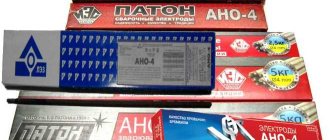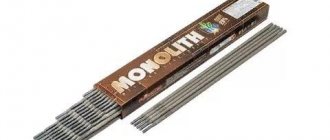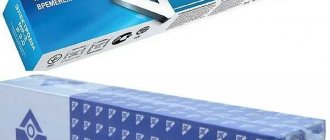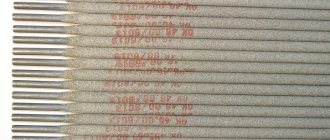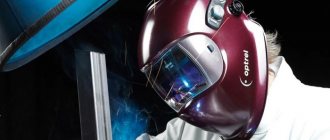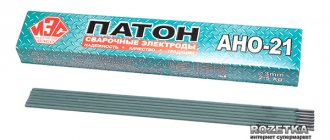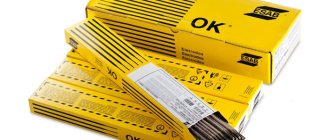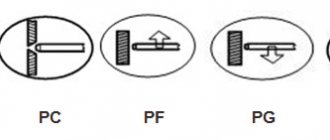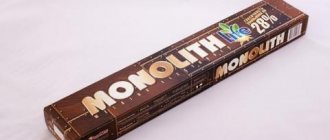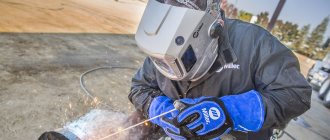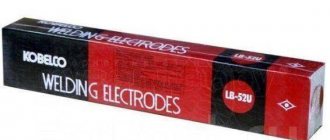Welding electrodes should be divided according to their purpose, the composition of the coating (its type), and methods of use (the type of welding current used). The principles of welding with coated rods are based on melting them using an electric current. In this case, the coating material simultaneously turns into a mixture of gases and protective slag, which protect the welding zone. The composition of the metal of the rod depends on the composition of the parts being welded: it can be steel, cast iron, a mixture of copper or aluminum with other (auxiliary) elements.
Classification by purpose
Electrodes are intended for welding:
- Steels: low-carbon, high-carbon, alloyed - including stainless and heat-resistant (austenitic).
- Cast iron - alloys with a high carbon content - 2.14% or more.
- Aluminum and alloys.
- Copper, brass and bronze.
Expert opinion
Dmitry Konstantinovich Levin
Electrodes are not always used for their intended purpose. Example: a steel (and stainless steel) additive is used to weld some cast iron alloys.
- For welding steels of different grades
- For working with cast iron alloys
- For aluminum welding
- For working with copper and its alloys
To ensure a high-quality connection, you need to try to ensure that the composition of the electrode material matches as closely as possible the alloy of the parts being welded.
Labeling example
When determining the alphanumeric combination, the manufacturer includes the following data:
- About the composition of the metal.
- Features of coating.
- Electrode diameter data.
Example: Uoni brand electrodes. On the package you can see the inscription: E42A-UONI-13/45-3,0-UD)/(E432(5)-B10.
To decrypt from left to right, the easiest way is to indicate the information in a column:
- E42A - electrode for manual arc welding. The resulting weld strength is 420 MPa. (A) - increased plasticity:
- UOSI 13 - brand name. The first letters are deciphered as follows: universal coating of the Scientific Research Institute No. 13;
- 45 — ultimate strength of surfacing — 450 MPa;
- 3,0 — diameter of the rod without taking into account the coating layer;
- U - indicates that they are intended for welding carbon steels and low-alloy structures;
- D — type of coating: thick;
- E432 (5) - the index indicates the characteristics of the seam, which should ideally be obtained;
- 43 — minimum tensile strength: not less than 430 MPa;
- 2 — relative elongation — from 24%;
- 5 — welding is possible at temperatures (minimum) down to -40˚С; this ensures the impact strength of the weld metal is 34 J/sq. cm;
- B - coating composition: basic;
- 1 — spatial position of the seam: any.
- 0 — welding is allowed only with an arc with constant characteristics (DC) and straight polarity.
The standard was originally developed back in the 40s of the 20th century. The compliance of domestic GOSTs with imported regulatory documents can be established using reference resources on the Internet. But those materials that are sold in Russia must already have certificates.
You may be interested in: Inverter welding machines. Rating of models, how to choose
Techniques and methods for welding thin sheet metals
Sometimes thin sheets need to be welded at an angle. In this case, it is more convenient to use the flanging method: the edges of the sheet are bent to the required angle, fastened with short transverse seams every 5-10 cm. Then they are welded as mentioned above: with a continuous seam from top to bottom.
The video shows how to weld thin sheet metal with an electrode using a welding inverter. The flanging method is used: the edges of the parts are bent, then secured in several places with short seams. This is followed by welding with a thin electrode 2 mm thick.
It is not always possible to avoid burn-through when welding without separation. Then you can try tearing off the arc for a few moments, and then lower the electrode again to the same place and move it a few more millimeters. So, tearing off and returning the arc, and cook. With this method, it turns out that the metal has time to cool down during the arc separation. In the video you will see how the color of the welding site changes after the electrode is removed. The main thing is not to let the metal cool too much.
Welding thin metal with arc separation is demonstrated in the first part of the video. The joining method is overlapped (one part overlaps the other by 1-3 cm), a rutile-coated electrode is used (for structural and low-alloy steels). Then the welding of stainless steel with a stainless electrode with the main coating is shown, and finally the ferrous metal joint is welded with the same stainless steel electrode. The seam, by the way, turned out to be of better quality than when using the recommended electrodes.
Read about choosing electrodes for welding with an inverter machine here.
If when welding thin metal it is not necessary to create a continuous seam, use a spot weld. With this small-sized welding method, the tacks are located at a short distance next to each other. This method is called an interrupted seam.
This is what an intermittent seam looks like on thin metal.
In general, it is difficult to butt weld thin iron. Overlapping is simpler: the parts don’t overheat so much and there’s less chance that everything will “go wrong.”
Read about the types of welds and connections here.
When electric butt welding thin metal, you can lay a thin wire with a diameter of 2.5-3.5 mm between the sheets (you can beat off the coating on damaged electrodes and use them). It is positioned so that on the front side it is flush with the surface of the metal, and on the back side it protrudes almost half the diameter. When welding, the arc is drawn along this wire. It takes the main thermal load, and the metal sheets being welded are heated by peripheral currents. At the same time, they do not overheat, they do not warp, the seam is smooth, without signs of overheating. After removing the wire, it is difficult to see any traces of its presence.
This is what a seam looks like when welding thin metal end-to-end with a heat-removing wire laid underneath
Another way is to place copper plates under the joint. Copper has very high thermal conductivity - 7-8 times higher than steel. Placed under the welding site, it removes a significant part of the heat, preventing overheating of the metal. This method of welding thin metals is called "heat pad welding".
Read how to weld a metal gazebo here. You might be interested in reading how to make a barbecue from a gas cylinder or metal? The thing is necessary and suitable for mastering welding.
Popular brands
For a number of reasons, some electrodes have become popular among professionals and amateurs.
Causes:
- Special quality of materials.
- Low cost per kilogram.
- Availability in most regions.
Expert opinion
Levin Dmitry Konstantinovich
But to obtain high-quality seams, it is recommended to choose electrodes that can be used to ensure a reliable connection of the starting materials.
Uoni-13/55
Electrodes are produced by a number of factories in Russia and CIS countries. Designed to work with low-carbon, low-alloy steels, and some grades of cast iron.
The result should be a seam with the following characteristics:
- Tensile strength - up to 530 MPa.
- Relative elongation - up to 24%.
- Yield strength - 420 MPa.
Recommended current for welding:
| Diameter, mm | 2 | 3 | 4 | 5 |
| Current value, A | 35-55 | 90-130 | 130-190 | 190-210 |
Expert opinion
Levin Dmitry Konstantinovich
Welding with direct current of reverse polarity is allowed.
MR-3S
Universal rutile electrodes are distinguished by the fact that they transfer metal well even to rusty, damp and dirty surfaces. Often used to work with pipelines and critical building structures.
The regulatory standard is GOST-9466. Features of the finished seam:
- Very viscous.
- Resistant to cracking.
- A thick layer of slag reliably covers the welding area.
Design parameters of seams after welding:
- Tensile strength - up to 480 MPa.
- Relative elongation - up to 25%.
- Yield strength - 410 MPa.
Recommended current for welding with different diameters:
| Diameter, mm | 2 | 2,5 | 3 | 4 | 5 |
| Current value, A | 30-70 | 50-90 | 70-130 | 140-200 | 160-260 |
Expert opinion
Levin Dmitry Konstantinovich
The MP-3S can operate on both alternating and direct current.
Lb-52U
Universal electrodes made in Japan by Kobelco. They differ in that they have passed international certification and certification by NAKS. Complies with GOST 9467-75.
Consumer Features:
- The slag reliably protects the welding zone and is easily removed.
- The arc burns well even with voltage fluctuations in the network.
- The likelihood of cracks forming inside the seams is minimal.
- During welding, minimal metal spatter is observed.
The seam is viscous and plastic.
Characteristics:
- Tensile strength - 530-546 MPa.
- Relative elongation - up to 31-35%.
- Yield strength - 441-455 MPa.
Recommended welding current:
| Diameter, mm | 2,6 | 3,2 | 4 |
| Current value, A | 60-90 | 90-130 | 130-180 |
It is allowed to work on direct and alternating current in all ways, except for welding in a vertical position from top to bottom.
It is required to calcinate the electrodes before welding - 140 degrees - for 60 minutes.
ANO-4
Universal electrodes with rutile coating for operation from AC or DC sources. GOSTs: 9466-75, 9467-75.
Steels can be welded together, provided that the carbon content in them is no more than 0.25%. Surfacing is also allowed. Welding positions are any except from top to bottom.
Characteristics of the resulting seams:
- Tensile strength - up to 430 MPa.
- Relative elongation - up to 20%.
- Yield strength - 390 MPa.
Recommended current:
| Diameter, mm | 3 | 4 | 5 |
| Current value, A | 80-150 | 120-180 | 150-230 |
Electrodes are packaged either in small tubes weighing up to 1.5 kg, or in packs of 5 kg.
ESAB OK 94.25
The electrodes are suitable for working with a number of materials:
- Burnt cast iron.
- Tin bronze.
- Brass.
- Copper.
Can be used for surfacing on steel surfaces to obtain corrosion-resistant layers.
Characteristics of the resulting seams:
- Tensile strength - up to 330-390 MPa.
- Relative elongation - up to 25%.
- The yield strength is 235 MPa.
Recommended current:
| Diameter, mm | 2,5 | 3,2 | 4 |
| Current value, A | 60-90 | 90-125 | 125-170 |
Technologists recommend heating parts before welding to 300 degrees. To control the temperature, you can use a portable pyrometer or thermal pencils.
ESAB OK AlMn1 (OK 96.20)
Electrodes for welding aluminum alloys without the use of inert gases. The composition of the rod is special: Mn (manganese) - 1.00%, Si (silicon) - up to 0.5%, Fe (iron) - up to 0.7%, Al (aluminum base) - everything else.
Information about the quality of the resulting joint: if the technology is followed, it is possible to obtain a seam that is not inferior in strength to the base metal.
Recommended current parameters:
| Diameter, mm | 2,5 | 3,2 | 4 |
| Current value, A | 50-90 | 70-110 | 90-130 |
Expert opinion
Levin Dmitry Konstantinovich
Because aluminum is soft, you need to press it lightly into the weld pool when welding.
The common electrode diameter is 2.4 mm. Length - 350 mm. Packed in sealed packs of 1-2 kg. Often sold individually.
Before welding, it is recommended to calcinate the electrodes at a temperature of 110-140 degrees for about 60 minutes. And the workpieces themselves - up to 150-300 degrees. You can only operate on direct current of reverse polarity.
ESAB OK 61.30
Electrodes for working with stainless steels, including those that operate under temperature loads.
Features of materials:
- The arc starts easily. Small amount of splashes during operation.
- You can cook in any position. Exception: top to bottom.
- The slag crust is easily separated.
Electrodes can be used on both alternating current and direct current.
Seam characteristics:
- Tensile strength - up to 560 MPa.
- Relative elongation - up to 43%.
- Yield strength - 430 MPa.
It is recommended to set the welding current:
| Diameter, mm | 1,6 | 2 | 2,5 | 3,2 | 4 | 5 |
| Current value, A | 35-50 | 45-65 | 60-90 | 80-120 | 120-170 | 150-240 |
Pre-calcination is not necessary.
Analogues of ESAB OK 61.30: KISWEL KST-308L (KISWEL, South Korea), AG E308L-16 (SUPERON, India), OZL-8 (Russia).
How to weld thin metal with an inverter
Welding machines that produce direct current are good because we can weld with reverse polarity. To do this, we connect the cable with the electrode holder to “+”, and connect “-” to the part. With this connection, the electrode heats up more, and the metal heats up minimally.
Read about how to choose a welding inverter for your home or cottage here.
It is necessary to cook using the thinnest electrodes: from 1.5 mm to 2 mm. In this case, you need to choose one with a high melting coefficient: then even at low currents the seam will be of high quality. The current is set to small. For electrodes measuring 1.5 mm it should be about 30-45 amperes, for a “two” - 40-60 amperes. In fact, sometimes they put it lower: it is important that you can work.
| Metal thickness, mm | 0.5 mm | 1.0 mm | 1.5 mm | 2.0 mm | 2.5 mm |
| Electrode diameter, mm | 1.0 mm | 1.6 mm - 2 mm | 2 mm | 2.0 mm - 2.5 mm | 3 mm |
| Current strength, A | 10-20 amps | 30-35 amps | 35-45 mm | 50-65 mm | 65-100 mm |
To ensure that the metal heats up less, the parts are placed in a vertical or at least inclined direction. Then they cook from top to bottom, moving the tip of the electrode strictly in this direction (without deflecting or returning). The tilt angle is forward, and its value is 30-40°. This way, the heating of the metal will be minimal, and this is one of the most important tasks for welding thin metals.
Electrode positions for welding and their use
General recommendation for choosing electrodes for welding thin metals: buy high-quality imported electrodes for such work. There will be many fewer problems.
Read about making a shed on a metal frame here.
Storage rules
Have you ever used a welding machine?
It happened! It didn’t happen
The main problem encountered during storage is high air humidity. The electrode coating quickly absorbs moisture, making it impossible to work with such filler material. The only way to correct the situation is to calcinate the welding electrodes.
For this, there are special ovens or portable canisters with heating elements. At home, it is recommended to store packages open (without polyethylene) at a temperature of 20-22 degrees, relative humidity 40-50%.
Wet electrodes can cause pores to appear on the surface and inside the seam, and an increase in metal spattering will also be observed.
To correctly select welding electrodes, you need to have a good understanding of what alloy you need to work with.
You should also carefully prepare the additive itself and the surfaces to be welded for the operation:
- Remove dirt and rust.
- Heat the electrodes.
- Set the welding current correctly.
If the technology is followed, you can count on obtaining seams with the characteristics specified by the electrode manufacturer.
Working principle of a welding electrode
Welding electrodes are ignited from the contact end, where an electric arc appears, melting the rod itself, as well as the surrounding space in the metal workpieces, under the influence of high temperature. Thus, at the point where the electric arc is formed, a bath of molten metal is formed. To make a seam and connect two parts of the workpiece, the welder must move the bath along the contour where the seam should pass in a spiral motion for better connection of the substance. Due to this, the temperature peak will shift, melting the yet unconnected elements, and the place where the ball bath is already filled with metal will cool, forming a permanent connection.
